|
My name is Willemijn, I am 24 and I am from the Netherlands. I am a person who stutters, and I was lucky to find the stuttering community pretty early in my life. When I was 19, I met other people who stutter for the first time. Meeting other people who stutter has helped me to grow as a person, and become more open, confident, and comfortable with who I am. It also inspired me to make art and share about my life as a person who stutters, to support others and spread awareness. |
One of the things I love about being around other people who stutter, is… hearing them stutter.
Every stutter has its unique rhythm and sound, and I think hearing them all together sounds so cool. As an artist, this inspires me and makes me wonder: what would stuttering look like if translated into a visual? In the comics I make about stuttering, I often symbolize the uniqueness of stuttering by drawing differently shaped speech bubbles. Some stutters have a lot of blocks and sound more harsh, which could translate into a geometric shape, with thick lines. Other stutters are more soft and quiet, with prolongations. Those could be drawn as a more organic shape, with flowy thin lines.
But that’s just my interpretation. What would it look like if everyone visualized their own stutter?
In August of this year, I had the opportunity to try out this idea. I was together with almost 50 people who stutter at an Erasmus+ Exchange, and was given the chance to host a workshop. At first, I was nervous about whether my workshop was going to make sense, and if people would enjoy it. For me, when an idea is too abstract, it doesn’t inspire me to be creative, and I was afraid that this would happen for the participants as well.
To my excitement, after introducing the idea and giving some examples of how sound can be translated into a visual, everyone jumped straight into creating. And it was even better than I could have imagined. Besides just creating the visual for what their stutter sounds like, the participants were expressing their thoughts, feelings and experiences into their artwork as well. It was beautiful to see that people discovered new things about themselves by seeing their inner world on paper. Emotional conversations happened, and I was so proud and impressed to see people open up and express themselves through art.
At the end of the workshop, we put all of our creations together, to make one collaborative artwork. And here it is! A visual representation of stuttering, made by 37 people who stutter. I’m really grateful for the experience of creating it together with all of you. Thank you to everyone who participated!
Below the images, you can read personal stories from four of the participants about their part of the artwork.
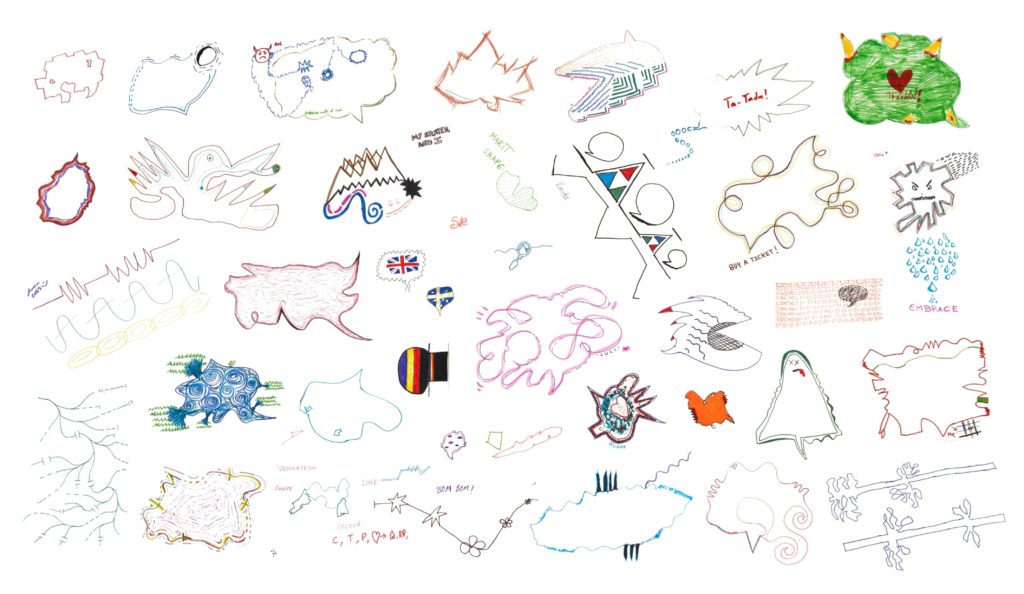
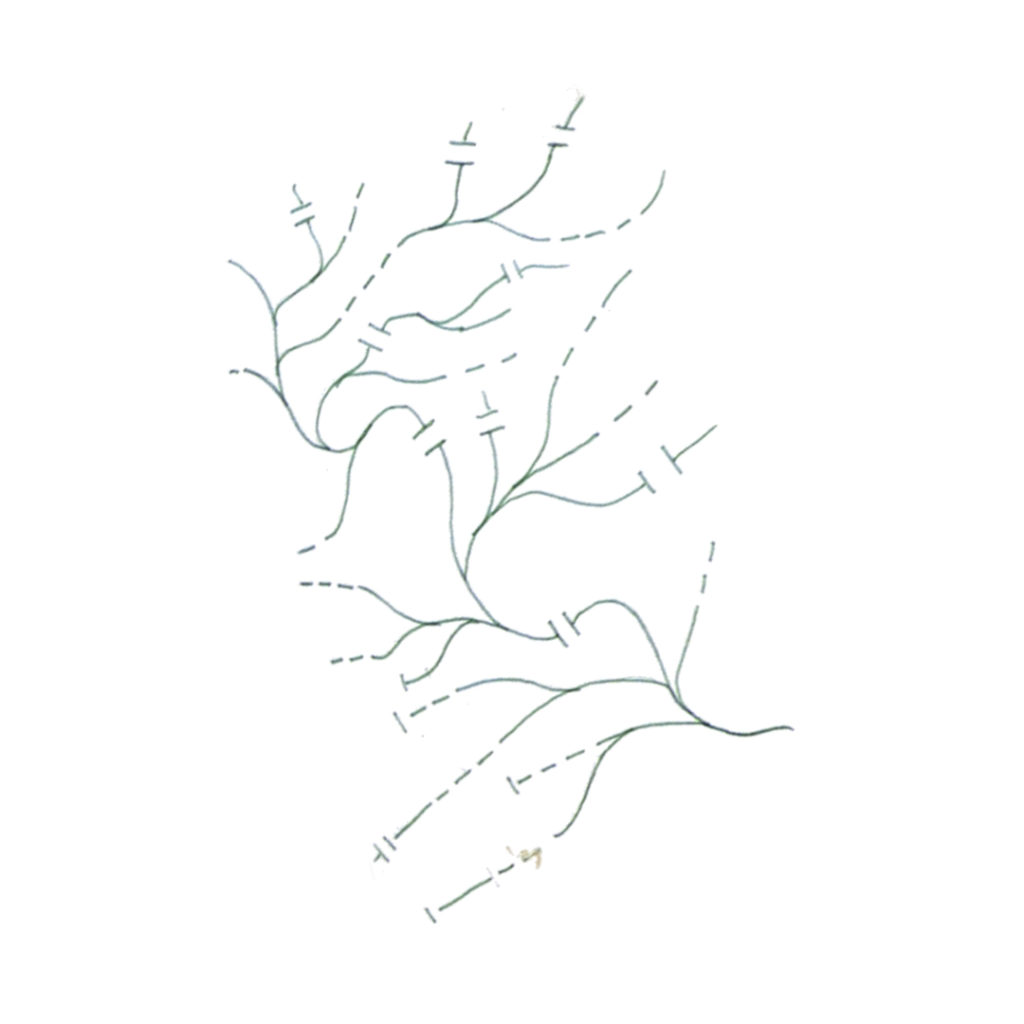
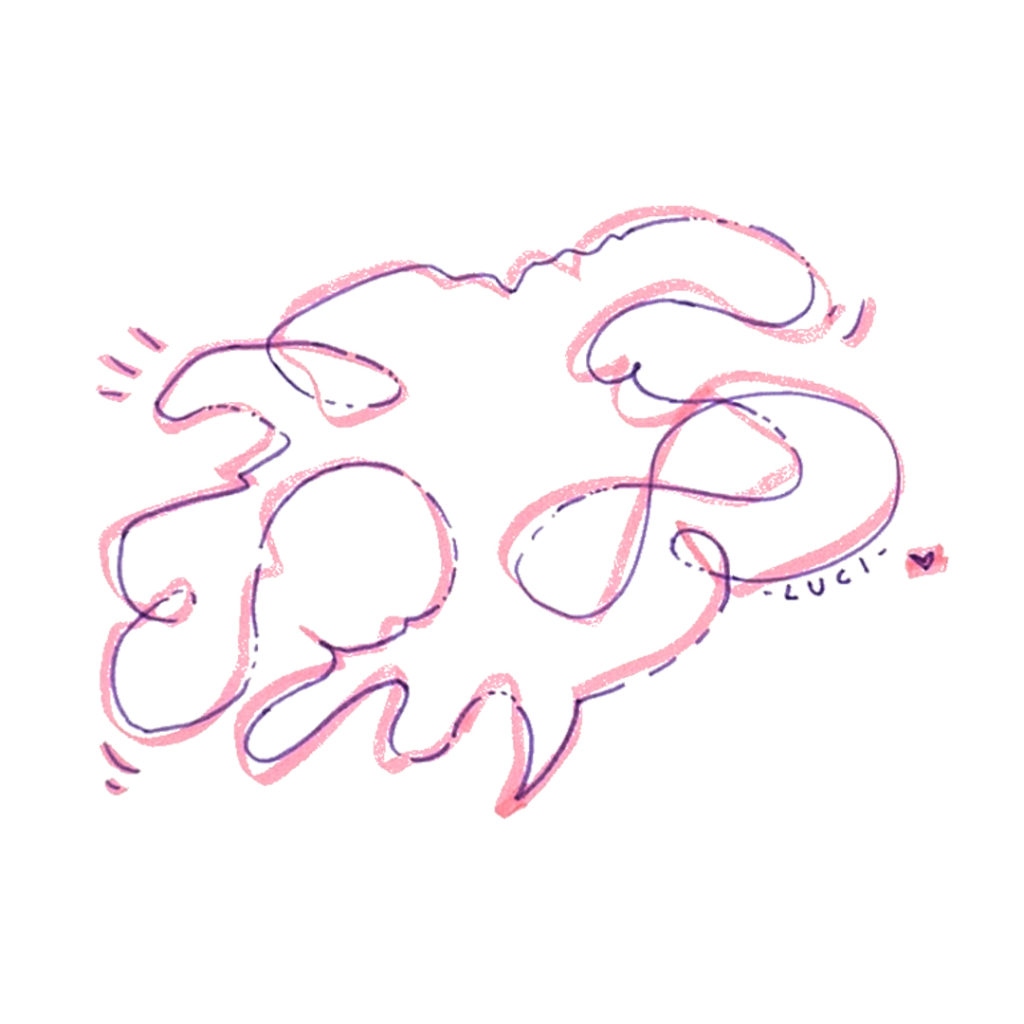
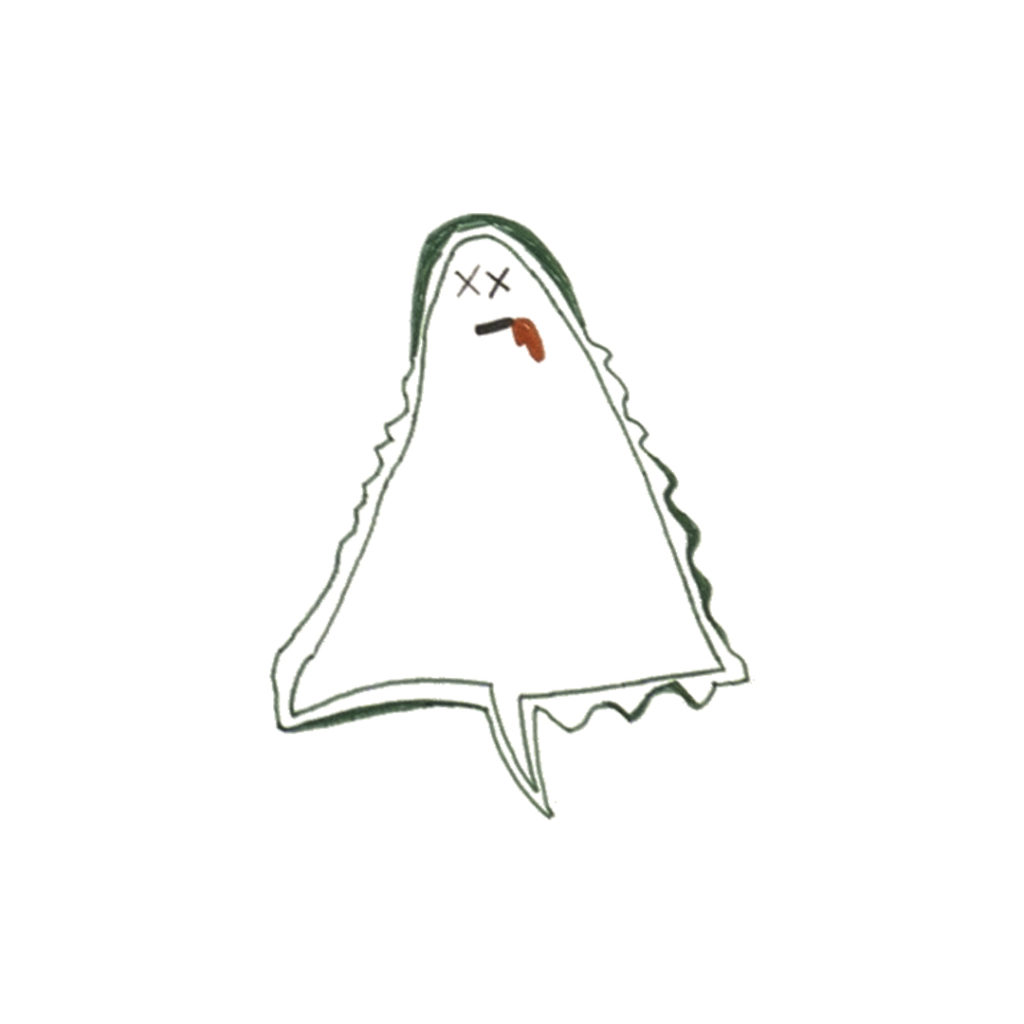

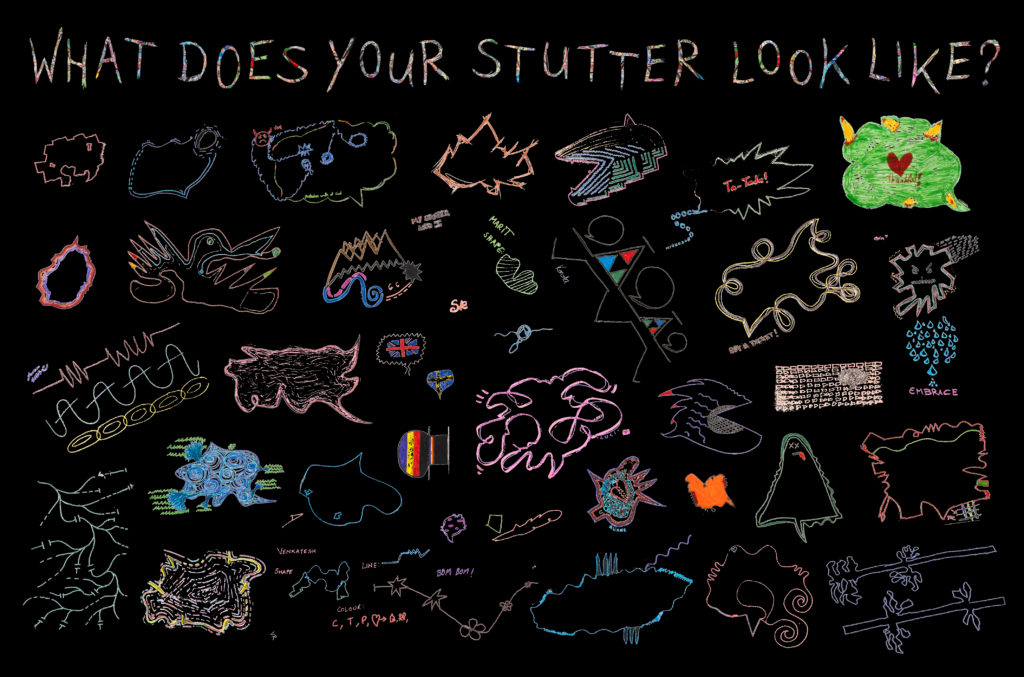
Andrea, Italy:
‘I chose to represent my stutter as a tree with branching limbs because it captures the complexity of my covert stuttering, where I often change my words and sentences mid-flow to avoid blocks or repetitions. The branches feature interruptions and dashed lines to symbolize the moments when blocks or repetitions happen. This visual metaphor reflects the intricate nature of my speech differences, where each branch represents a potential linguistic detour. Through this artwork, I’ve come to realize that my stutter is an integral part of my identity and the way I think. In the future, I hope to continue embracing and understanding this aspect of myself, using it as a source of strength rather than a hindrance to my communication.’
Lucía, Spain:
‘On one hand, the darker lines of my stutter bubble are round and twisting because I try to avoid certain words in order not to stutter, so usually I have to reformulate all the sentence just for one specific word. However, this strategy does not always work and I usually repeat certain syllables, I lengthen some sounds or I just block for a bit. These are represented by interruptions in the darker line in form of blanks, dots or shorter lines. On the other hand, the lighter line represents my flow of thoughts which, on the contrary, is not interrupted and guides my speaking. Finally, these two lines follow the same path because, despite these difficulties, I eventually get to express what I need to say, which is the main goal of communication.’
Oskari, Finland:
‘In my drawing, the inner line represents the thoughts that run through my head, and that I’d like to say out loud. The outer line represents, how the words come out of my mouth: sometimes it’s more wobbly (stutter) and sometimes it’s straight (fluent). Usually when it wobbles, the line gets thinner because at those times I tend to limit myself and not speak as loud and as much as I’d like to. The expression on the creature’s face is the one I feel when I cannot express myself as I’d like to because of the wobbliness. It is shaped like a ghost because at those times my stutter feels like a ghost that is haunting me: even at times when I speak fluently.’
Konsta, Finland:
‘My speech is otherwise fairly fluent, but I have these really heavy blocks, which the triangles are for. The smaller triangles are the different reasons for the blocks, f.e. I’m not breathing properly, I’m speaking too quickly or I’m not focused enough. I realized, that even though stuttering is not “normal”, I shouldn’t care, cause being normal is boring.’
Thanks to Alinde, Katariina, Yelco, Sveva, Lotus, Annette, Anurag, Jeffrey, Lucía, Wesley, Oskari, Marialaura, Antti, Genevra, Valerijo, Venkatesh, Lisa, Gabriele, Mea, Marit, Dario, Andrea, Konsta and everyone else who participated!
![]()

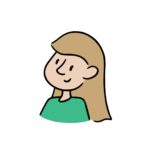
Hi Willemijn,
First, thank you for sharing your art in social media. It´s inspiring for so many people around the world. Second, I love how everyone represented their stutter in so many different ways and it reflects the individuality of stuttering! Also, it´s nice to see that I know a couple of people from the group!:D
I can´t wait to ask my clients to do the same activity!:)
Hey Cynthia, thank you for your kind words! 🙂 Yes, isn’t it cool to see? Let me know how it goes and what the results are when you will try this out with your clients! 😀
Hi Willemijn,
Thank you for sharing your passion for art. Art is a beautiful way to capture the thoughts, feelings, and experiences of individuals who stutter. Individuals who stutter encounter unique experiences, and using art provides a greater understanding of the perspective of individuals who stutter. Personally, I grasp a better understanding of the thought process of others through a visual. The artwork of individuals who stutter helped me learn everyone’s unique perspective on how they view stuttering.
Hello Bianca, thank you for your kind comment and for sharing your perspective! I can relate with you, and I am learning a lot from others from how they visualize their stutter. I am really excited to try this out with more people and to see their creativity.
Willemijn,
What a super cool idea! I love the idea of portraying stuttering as an art form. It is amazing how unique stuttering is and how it effects people differently. Have you had any instances when this technique has allowed a friend/client to have a break through in their stuttering or acceptance of stuttering?
Thanks for sharing,
Rebecca
Hey Rebecca, thank you!! As of now I’ve only done this workshop once, but I did notice how creating the art allowed people to face some difficult feelings. There were people who had emotional realisations and some beautiful conversations happened because of it. One of the participants said that my workshop made her feel bad, but ‘in a good way’. In a way that allowed her to feel feelings she needed to feel, and heal. I was very proud of that!
Willemijn, I have appreciated your art on social media and the artwork depicted here. Thank you for sharing your creativity and talent with us!
Thank you so much Ana Paula!
Hi Willemijn,
This is such a great idea and I love how well your idea worked out at the Erasmus+ Exchange. It is so cool to see how differently people expressed their view of their stutter through art. Each of the pieces is so intricate and unique to the person. Thank you for sharing this!
– Katrina
Thank you Katrina! ☺️
Hi Willemijn, I am very inspired by your creativity with incorporating artwork and stuttering. I think it is a wonderful thing to have created an outlet for yourself and people who stutter to come together and depict themselves and their stuttering into artwork. I think creating artwork allows for others to see the heart and soul of the individual who created it. I think it is beautiful you created this opportunity for others to express themselves and depict their stuttering in this way. I loved taking the time to study each piece created individually and collectively and how each represented someone’s life. All the individual pieces really struck me, in particular Andrea’s, where I see how her speech was symbolic to growing branches represented as continuous speech, and blocks and repetitions as the parts where speech stopped and then became continuous again. Thank you for creating this beautiful outlet!
Thank you! I love that you carefully looked at every piece, there’s so much to find in every drawing. Sometimes I discover things about my own stutter when looking at others. Thank you for taking the time to appreciate the artwork! ☺️
Hi Willemijn,
This was very beautiful! I love your idea for this workshop and the outcomes were amazing to see. And then reading about the thoughts and feelings of the artists was very eye opening to the individual experience of stuttering. The creative inspiration of drawing out your thoughts and feelings on such a personal level was incredible and I could see how this could be a healing processes. As a future SLP (currently in graduate school), would this be functional to implement into therapy sessions?
Courtney
Hey Courtney, thank you! Yes, I think making a drawing of your stutter in this way is a really good conversation starter. I’m not a therapist but I really felt like the drawings allowed people to connect with their feelings and make new discoveries about themselves. Doing it in a group also helps a lot in this process. If you ever try it out, let me know how it goes ☺️ (and let me know if you have a question about it!)
Willemijn
How creative! Many people like visuals and I never thought of putting a visual to the uniqueness of a person’s stutter. I am glad that the workshop you gave was even better than imagined. Many people respond to visuals, and this idea could be used in treatment. Maybe a client could draw a visual of their stutter, and later draw another one. At the very least, it would allow them to know their uniqueness. As you stated, “It was beautiful to see that people discovered new things about themselves by seeing their inner world on paper.” Abstract ideas are good!
Thank you!! I agree, I think doing a drawing exercise like this can really start conversations, especially when done in a group. I like your idea of making another drawing later, that would be very interesting to see. Thank you for sharing your thoughts!
What you add to the Youth Exchanges is gold! To have had the honor to follow your footsteps, from where you were to where you are now, and now paying it forward, is such a joy! You’re getting YPWS to put their emotions into art, and come to realisations to step out of their comfort zones. And your art helps people from all over the world to recognise themselves and finally open up and share what they’ve wanted to share for so many years. Zo trots op je! <3
Happy ISAD and keep cartooning
Anita
Thank you Anita, for your support now and through those years ☺️
Oh, and HAPPY ISAD! 😁
Hi Willemijn,
Thank you for sharing your personal experience with stuttering. I loved hearing your perspective on the uniqueness of how different people stutter and cannot wait to share this idea with students on my caseload who stutter. The workshop you that you hosted sounds like an incredibly empowering experience and I can imagine help people who are struggling with self acceptance to celebrate their uniqueness. You mentioned that you were lucky enough to find a stuttering community pretty early on, is this something you sought out on your own? Could you recommend some steps that a person who stutters can take to find/build a community around them.
Ohh thank you! I’d be very honoured if you shared this with your students. I deed seek out the stuttering community on my own, and I found it by looking for online stuttering groups. Some of them are more positive and useful than others, so that’s something to keep in mind. One of them I really like is Stamily, which is an international stuttering community that has both in-person and online events. It has members who stutter from all over the world, and people can sometimes find people in their country via this group to meet up. Meeting other people who stutter really helps to talk about it and to build a supportive network.
Having a supportive network is what has helped me the most!